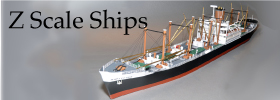- Posts: 335
- Thank you received: 2
Wiring 22 or 24 gauge?
- TerryH
- Offline
- Premium Member
-

So my question is a simple one, what wire should I be using for control tracks, switches and DC LEDs? And where can I buy some, possibly in Canada.
Please Log in or Create an account to join the conversation.
- Socalz44
- Offline
- Moderator
-

- Posts: 1132
- Thank you received: 59
Please Log in or Create an account to join the conversation.
- TerryH
- Offline
- Premium Member
-

- Posts: 335
- Thank you received: 2
Please Log in or Create an account to join the conversation.
- Socalz44
- Offline
- Moderator
-

- Posts: 1132
- Thank you received: 59
Please Log in or Create an account to join the conversation.
- zthek
- Offline
- Junior Member
-

- Posts: 137
- Thank you received: 0
I am using 8A,
8A? Where? Can you clarify?
Lajos:unsure:
Please Log in or Create an account to join the conversation.
- zmon
- Offline
- New Member
-

- Posts: 93
- Thank you received: 0
With regards to train sets, DC systems (those that use transformers) should be wired with braded wire to compensate for voltage drop over longer runs, and to more eficently carry the weaker DC power. On DCC layouts its advised to use solid copper wire for Buss runs as well as track feeder wires given that DCC systems opperate on AC voltage.
From what i've be told, DC power is weaker and has more resistance (thus voltage drop) and benifits by the multi stands in braded wire to carry its power with the least amount of drop. Conversly with AC voltage, it is in a sine wave and prefers to travel in a single conductor wire to maintain its sine wave over greater distances.
Practicality with Z scale; The reality is that none of the locos or powered devices that are commercially available for Z scale consume large amounts of amperage (power), so wire sizing is simplified. Additionally, given the small size of most Z scale layouts, the runs of wire are not long enough to have much if any decernable voltage drop, so again wire sizing is simplified. Wire size charts that use voltage and load (amperage) are available on the internet for folks that want to really get down to particulars. 20-22 gauge braded wire should be more that sufficent on most DC Z scale layouts. Marklin sells a full line of their recomended wire in all the colors needed to follow their wiring system, and i think its 22 gauge. On DCC i was recomeded to use (and followed on my modules) 14-16 guage single conductor wire for buss runs and 20-22 gauge single conductor for track drop feeders. A good source for single condutor wire is Home Depot or Lowes type store. You can buy rolls of the 14 or 16 guage, and the 22 gauge feeders can be stripped out of CAT-type comunications wire. CAT wire comes in numbers from 2-12 and this simply corolates to the number of pairs of wires in the cable. Remove the outer jacket, and the colored pairs of wire are inside, and jacketed. I use CAT-5 myself so i have five colored pairs of wires to chose from when i strip them out..
Hope this helps folks out, and please add any information that i missed, or correct me if i stated something wrong...
Tony B...
Wasatch Z ClubB)
Please Log in or Create an account to join the conversation.
- TerryH
- Offline
- Premium Member
-

- Posts: 335
- Thank you received: 2
Please Log in or Create an account to join the conversation.
- Havoc
- Offline
- Junior Member
-

- Posts: 187
- Thank you received: 0
On DC systems (like your car) its common practice to use braded wires in the apropriate gauge to cover your load. On AC systems (like your house) its common practice to use solid copper wire, again in the apropriated gauge to cover your load.
With regards to train sets, DC systems (those that use transformers) should be wired with braded wire to compensate for voltage drop over longer runs, and to more eficently carry the weaker DC power. On DCC layouts its advised to use solid copper wire for Buss runs as well as track feeder wires given that DCC systems opperate on AC voltage.
From what i've be told, DC power is weaker and has more resistance (thus voltage drop) and benifits by the multi stands in braded wire to carry its power with the least amount of drop. Conversly with AC voltage, it is in a sine wave and prefers to travel in a single conductor wire to maintain its sine wave over greater distances.
Euh??? Please brush up your elementary electricity before putting such things on a forum.
The choice for stranded or solid wire has nothing to do with AC or DC. It has all to do with metallic section, resistance and flexibility. In your car the wire has to be bended quite a lot and has to resist vibration and adjust to large temperature variations hence they use stranded wire as it is far more flexible. In your house you need the maximum of copper in a given section and as the wire is once installed and never moved they use solid wire as for the same overal diameter a solid wire has more copper than a stranded one. Also the used termination, screw termination like in the wiring of your house is more reliable with solid wire.
The power of AC or DC is the same: 1W is 1W. It doesn't matter for electricity what wire it uses as long as we're talking about power wiring, antennas are a different issue. The voltage drop over a wire (resistor) is the same for AC as for DC: V= IxR.
The distance issue with DC has to do with the ability to change the voltage. In very long runs the resistance of the wire becomes important. Now for power distribution you don't want loss. So for a given power, if you use a higher voltage you have less current, so you have less voltage drop and less loss. Now to make a higher voltage (and reduce it later) is far easier with AC because you can use transformers. There are a few complications but those can be discarded here (unless you're into 300kV lines over a few 100km). That's the main reason they use AC in power transmission: it is easier to change the voltage up/down and take advantage of that.
i was recomeded to use (and followed on my modules) 14-16 guage single conductor wire for buss runs and 20-22 gauge single conductor for track drop feeders. A good source for single condutor wire is Home Depot or Lowes type store. You can buy rolls of the 14 or 16 guage, and the 22 gauge feeders can be stripped out of CAT-type comunications wire. CAT wire comes in numbers from 2-12 and this simply corolates to the number of pairs of wires in the cable. Remove the outer jacket, and the colored pairs of wire are inside, and jacketed. I use CAT-5 myself so i have five colored pairs of wires to chose from when i strip them out..
This is a good system. Use a bus that follows your main track using wire like for your house wiring (easy to find and reasonably cheap), then from there smaller feeders. CAT-5 would be my choice as well: easy to find, cheap and easy to work with. But take apart such a cable and you will see that there are only 4 pairs in it! The numbers stand for the performance of the cable in terms of bandwidth.
Please Log in or Create an account to join the conversation.
- TerryH
- Offline
- Premium Member
-

- Posts: 335
- Thank you received: 2
Please Log in or Create an account to join the conversation.
- SJ-BAZ-man
- Offline
- DCC Moderator
-

- Posts: 197
- Thank you received: 4
If you truly have an 8 Amp supply, I assume it is DCC. If so, the supply will protect itself in ~0.5 seconds, repeatedly so there really isn't a power dissipation issue.
If you are using an O or G scale 8 Amp DC power pack, I would recommend either changing to an appropriate lower current Z or N power pack (pick ANY one) or, use it as a voltage source for a smaller hand-held self limiting controller like a Ztek or Joerger that will give you much better DC speed control.
Jeff
SF Bay Area Z
Please Log in or Create an account to join the conversation.
- TerryH
- Offline
- Premium Member
-

- Posts: 335
- Thank you received: 2
Please Log in or Create an account to join the conversation.
- Todd
- Offline
- New Member
-

- Posts: 32
- Thank you received: 0
The VA thing can be confusing, but thats how they rate model railroad power packs. I think it was because Lionel packs are AC and the volt-ampere is more often in AC terms, at least according to Wikopedia. It was explained to me that VA is volts times amps, which in most other electrical terms would be watts, but tradition is strong in model railroading, so we call them volt-amperes. If you have 8 volt-ampere power pack and divide by the max voltage of 10 you get .8 amps, which is power rating of a white Marklin pack.
Given .8 amps, the typical draw of a Z locomotive is something .2 amp, so the Marklin pack has plenty of juice for the job. I've run three MT F7's and GP's on one with no problems. I just hate that damned lever....
Please Log in or Create an account to join the conversation.
- TerryH
- Offline
- Premium Member
-

- Posts: 335
- Thank you received: 2
Please Log in or Create an account to join the conversation.
- Havoc
- Offline
- Junior Member
-

- Posts: 187
- Thank you received: 0
I'm using a power bar with a circuit breaker for the three power packs as well as the ac/dc adapter
While that is a good idea it won't help when shorting the output of your transformers. Check the fuse rating on the power bar and see what the maximum is the power packs can deliver. Now calculate how much power your bar can deliver before the fuse blows (voltage on the house in volts wiring multiplied by fuse rating in amps). probably it is only a tiny fraction.
You need to check each pack if it is protected on the output. Likely there are symbols on the back or bottom telling you it is fused (and what rating) or thermally protected.
Please Log in or Create an account to join the conversation.
- TerryH
- Offline
- Premium Member
-

- Posts: 335
- Thank you received: 2
Please Log in or Create an account to join the conversation.
- Havoc
- Offline
- Junior Member
-

- Posts: 187
- Thank you received: 0
The only real fire potential I can see is if the Regulated Adapter goes up in smoke. Not sure how to avoid this other then checking the load across it.
Check if there isn't any marking on it like the symbol here commons.wikimedia.org/wiki/File:Fuse_symbol_Europe.svg indicating there is a fuse inside, or commons.wikimedia.org/wiki/File:Thermistor.svg to indicate a hermal safety. It doesn't tell you for that last if it resets itself but at least you kow something.
Something you could do to make sure is go to a car accesory or electronics shop and ask for an inline fuseholder. Something like this type is easiest: www.radioshack.com/product/index.jsp?productId=2102784 and buy 1A slow fuses to go with it. Then put it in one of the wires from your adaptor.
Please Log in or Create an account to join the conversation.
- TerryH
- Offline
- Premium Member
-

- Posts: 335
- Thank you received: 2
Please Log in or Create an account to join the conversation.
















